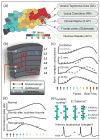Auditory map plasticity: diversity in causes and consequences
- PMID: 24492090
- PMCID: PMC4206409
- DOI: 10.1016/j.conb.2013.11.009
Auditory map plasticity: diversity in causes and consequences
Abstract
Auditory cortical maps have been a long-standing focus of studies that assess the expression, mechanisms, and consequences of sensory plasticity. Here we discuss recent progress in understanding how auditory experience transforms spatially organized sound representations at higher levels of the central auditory pathways. New insights into the mechanisms underlying map changes have been achieved and more refined interpretations of various map plasticity effects and their consequences in terms of behavioral corollaries and learning as well as other cognitive aspects have been offered. The systematic organizational principles of cortical sound processing remain a key aspect in studying and interpreting the role of plasticity in hearing.
Copyright © 2013. Published by Elsevier Ltd.
Figures

Similar articles
-
Cortical tonotopic map plasticity and behavior.Neurosci Biobehav Rev. 2011 Nov;35(10):2117-28. doi: 10.1016/j.neubiorev.2011.02.002. Epub 2011 Feb 17. Neurosci Biobehav Rev. 2011. PMID: 21315757 Review.
-
Auditory cortex mapmaking: principles, projections, and plasticity.Neuron. 2007 Oct 25;56(2):356-65. doi: 10.1016/j.neuron.2007.10.013. Neuron. 2007. PMID: 17964251 Free PMC article. Review.
-
Neural maps in insect versus vertebrate auditory systems.Curr Opin Neurobiol. 2014 Feb;24(1):82-7. doi: 10.1016/j.conb.2013.08.020. Epub 2013 Sep 20. Curr Opin Neurobiol. 2014. PMID: 24492083 Review.
-
Learning to hear: plasticity of auditory cortical processing.Curr Opin Neurobiol. 2007 Aug;17(4):456-64. doi: 10.1016/j.conb.2007.07.004. Epub 2007 Aug 21. Curr Opin Neurobiol. 2007. PMID: 17714932 Review.
-
Contributions of the thalamocortical system towards sound-specific auditory plasticity.Neurosci Biobehav Rev. 2011 Nov;35(10):2155-61. doi: 10.1016/j.neubiorev.2011.02.010. Epub 2011 Feb 22. Neurosci Biobehav Rev. 2011. PMID: 21349286 Review.
Cited by
-
Manipulation of low-level features modulates grouping strength of auditory objects.Psychol Res. 2021 Sep;85(6):2256-2270. doi: 10.1007/s00426-020-01391-4. Epub 2020 Jul 20. Psychol Res. 2021. PMID: 32691138
-
Passive stimulation and behavioral training differentially transform temporal processing in the inferior colliculus and primary auditory cortex.J Neurophysiol. 2017 Jan 1;117(1):47-64. doi: 10.1152/jn.00392.2016. Epub 2016 Oct 12. J Neurophysiol. 2017. PMID: 27733594 Free PMC article.
-
Behavioral relevance helps untangle natural vocal categories in a specific subset of core auditory cortical pyramidal neurons.J Neurosci. 2015 Feb 11;35(6):2636-45. doi: 10.1523/JNEUROSCI.3803-14.2015. J Neurosci. 2015. PMID: 25673855 Free PMC article.
-
Cortical Synaptic Inhibition Declines during Auditory Learning.J Neurosci. 2015 Apr 22;35(16):6318-25. doi: 10.1523/JNEUROSCI.4051-14.2015. J Neurosci. 2015. PMID: 25904785 Free PMC article.
-
Adenosine A1 Receptor mRNA Expression by Neurons and Glia in the Auditory Forebrain.Anat Rec (Hoboken). 2018 Nov;301(11):1882-1905. doi: 10.1002/ar.23907. Epub 2018 Oct 12. Anat Rec (Hoboken). 2018. PMID: 30315630 Free PMC article.
References
Publication types
MeSH terms
Grants and funding
LinkOut - more resources
Full Text Sources
Other Literature Sources

